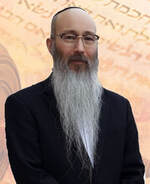|
By: HaRav Menashe Sasson Reporting from Jerusalem, Israel Published in the U.S.A. Parashat BeHar Sinay [בהר סיני] begins, “And the Lord spoke to Moshe in mount Sinay. . . .” Vayyiqra 25:1. The root of the Hebrew word “BeHar” is “Har [הר],” which means “mount” or “mountain.” The first letter of the word “BeHar [בהר] is the Hebrew letter “bet” [ב], which means “in” or “with.” Thus, BeHar [בהר] means “in the mountain” or “with the mountain.” “Sinay” [סיני] is the name of the mountain. “The mountain,” which is located outside of, but on the way to Eretz Yisra’el from Misrayim (Egypt), is the location where the Jewish people received the Torah. In Parashat BeHar Sinay, we learn that HaShem brought the Jewish people “out of the land of Misrayim to give [them] the land of Kena’an,” that is, to give the Jewish people Eretz Yisra’el, “and to be [their] G-d.” Vayyiqra 25:38. This brings us to the misva of Yishuv Eretz Yisra’el [ישוב ארץ ישראל], that is, the misva to settle in Eretz Yisra’el, also known as making Aliyah [עליה], which in Hebrew literally means to “go up.” The Talmud states:
T.B. Masechet Ketuvot 110b, quoting Vayyiqra 25:38. Furthermore, the misva of living in Eretz Yisra’el is timeless. The Shulkhan Arukh states that: “If [a husband] proposes to ascend to Eretz Yisra’el and [the wife] does not want to [go], [the husband] must divorce her. . . . [And if the wife] proposes ascending [to Eretz Yisra’el] and [the husband] does not want to [go], he must divorce her.” Shulkhan Arukh, Even HaEzer 75:4. Some, however, are of the opinion that, prior to the Redemption, it is forbidden to Yishuv Eretz Israel [ישוב ארץ ישראל], that is, to make Aliyah [עליה] and settle in Eretz Yisra’el. This belief is typically based on three verses from Shir Ha’Shirim [שיר השירים], one of which occurs twice: “I adjure you, O daughters of Yerushalayim, by the gazelles or by the hinds of the field, that you stir not up, nor awake my love, until it please,” Shir Ha’Shirim 2:7, 3:5, and another similar verse that occurs once: “I adjure you, O daughters of Yerushalayim, that you stir not up, nor awake my love, until it please.” Id. 8:4. A Midrash that is discussed in the Talmud explains that the three verses from Shir Ha’Shirim [שיר השירים] refer to three oaths, two of which HaShem elicited from the Jewish people and one which He elicited from the nations (“Three Oaths”). The Talmud explains that the Three Oaths are: (1) the Jewish people should not ascend to Eretz Yisra’el as a wall, but little by little; (2) the Jewish people should not rebel against the rule of the nations of the world; and (3) the nations of the world should not excessively subjugate the Jewish people. T.B. Masechet Ketuvot 111a. In Hebrew, the phrase that “the Jewish people should not ascend to Eretz Yisra’el as a wall [שלא יעלו ישראל בחומה] has been interpreted by the Rabbis to mean that the Jewish people should not “break-in” to Yerushalayim, that is, should not take Yerushalayim by force. Although the Midrash which discusses the Three Oaths appears to have been written in an effort to prevent a recurrence of the defeat which the Jewish people suffered at the hands of the Romans as a result of the Bar Kokhba revolt (c. 132 C.E. – 136 C.E.), it must, nevertheless, be conceded that the Midrash itself is silent on the issue of whether the Three Oaths were intended to be permanent or limited to a particular period of time. There are, however, at least four reasons why the Three Oaths were either never binding Halakha, or no longer constitute binding Halakha. First, an “oath,” by definition, is a promise or statement which is made by an individual while invoking the name of HaShem. It is questionable whether a nation – the Jewish people as a whole – are capable of taking an oath, as in all likelihood, not all members of the nation would – or did – agree to be bound by the oath. At most, only members of the nation who actually agreed to be bound by an oath would be subject to its terms. Therefore, because a nation is not capable of taking an oath, it follows that a nation cannot be bound by the terms of an oath. Thus, the Three Oaths are not, and never were, binding Halakha. Second, the Three Oaths were never binding on the Jewish people because the Midrash which discusses them is Aggadic in nature (commentary on the non-legal aspects of the Tanakh), as opposed to Halakhic in nature (an explanation of the legal aspects of the Humash). Halakha (Jewish law) generally requires at least some rabbinical consensus and typically involves the issuance of legal opinions. The purpose of Aggadah, on the other hand, is to motivate the masses by teaching moral, metaphysical, and mystical lessons. Accordingly, Aggadah is not subjected to the rigors which are present in the development of Halakha. For this reason, Halakha is not derived from Aggadah. Shmuel ben Hofni Gaon (969 C.E. – 1034 C.E., Babylon), one of the last of the Geonim and the author of Mevo HaTalmud [מבוא התלמוד] (Introduction to the Talmud), which is appended to most editions of T.B., Masechet Brachot, wrote that any commentary in the Talmud that does not relate to a misva from the Torah is Aggadah and that Aggadah should be incorporated into Halakha only when it is logically sound to do so. Authorship of Mevo HaTalmud [מבוא התלמוד] is generally attributed – although erroneously – to Shmuel ibn Naghrillah, who is better known as Rabbi Shmuel HaNagid (Shmuel the governor) [שמואל הנגיד] (993 C.E. – c. 1056 C.E., Spain). Shir Ha’Shirim is a poetic, not a legal, text and does not relate to a misva from the Torah. Thus, the Three Oaths are Aggadic in nature. Although it may have been logically sound to incorporate the Three Oaths into Halakha for some period of time immediately following the Bar Kokhba revolt, the rationale for doing so no longer exists. Therefore, today, the Three Oaths have no Halakhic application. Third, neither the oath to not ascend to Eretz Yisra’el as a wall [שלא יעלו ישראל בחומה], that is, to not “break-in” to Yerushalayim, or the oath to not rebel against the nations, have been violated. Medinat Yisra’el, the modern-day State of Israel came into existence on May 14, 1948, as the result of international agreement in the form of a resolution of the United Nations General Assembly. Acting in accordance with a United Nations resolution can hardly be construed as ascending to Eretz Yisra’el as a “wall,” “breaking-in to Yerushalayim, or rebelling against the nations of the world. The fact that the State of Israel was attacked by all of its Arab neighbors immediately after it declared its independence, although important for other reasons, is of no Halakhic consequence in the context of the Three Oaths. Fourth, the nations of the world unnecessarily subjugated the Jewish people during the Holocaust [שואה], thereby releasing the Jewish people from any oaths which may have applied to them. In conclusion, we know from the Talmud and Halakha that it is a misva to Yishuv Eretz Yisra’el [ישוב ארץ ישראל], that is, to settle in Eretz Yisra’el. We learn from Parashat Behuqqotay that HaShem promises the Jewish people blessing if we keep His Torah. We also learn, from the Admonition [תוכחה], that there are consequences for not keeping the Torah. May we all keep the Torah to the best of our ability, including – and perhaps especially – the misva of Yishuv Eretz Yisra’el [ישוב ארץ ישראל] when it is possible for a person to do so, and to receive HaShem’s bountiful blessings. שבת שלום Shabbat Shalom! Copyright © The Israel Foundation. All Rights Reserved.
0 Comments
Your comment will be posted after it is approved.
Leave a Reply. |
THE ISRAEL FOUNDATION





